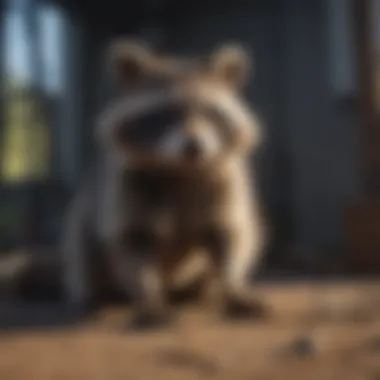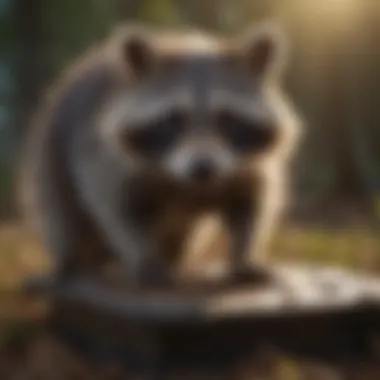Proven Methods for Ethical Raccoon Control: A Comprehensive Guide


Preventive Pest Control Strategies
When it comes to effectively managing raccoon infestations, implementing preventive pest control strategies is crucial. One of the key areas to focus on is protecting the exterior of your house. Begin by meticulously sealing any cracks or openings that could serve as entry points for raccoons. Clearing debris around your property is also essential, as clutter can attract pests. Moreover, prevent pests from entering by installing barriers such as screens on windows and doors.
In addition to safeguarding the exterior, maintaining your yard is vital. Establish essential yard care routines, including regular mowing, trimming of bushes, and removing standing water where pests could breed. Implement methods for keeping your yard pest-free, such as applying natural repellents or setting up physical barriers to deter raccoons.
Furthermore, maintaining indoor cleanliness plays a significant role in pest prevention. Utilize expert cleaning tips and techniques to keep your home free from food remnants and clutter that may attract raccoons. Additionally, create a pest-resistant indoor environment by sealing any gaps around pipes and vents.
Proper garbage disposal is another critical aspect of preventive pest control. Ensure efficient waste disposal methods are in place to prevent raccoons from being attracted to your property. Emphasize the importance of sealing garbage cans securely and avoiding leaving trash outside for extended periods.
Lastly, explore innovative pest prevention strategies to further safeguard your home. Consider utilizing motion-activated lights, ultrasonic repellents, or planting natural pest-repelling herbs around your property. These additional measures can supplement traditional pest control methods and enhance the overall effectiveness of your raccoon prevention efforts.
Understanding Raccoons
Understanding raccoons is crucial in tackling infestations effectively. By delving into the behavioral traits and common risks associated with these creatures, homeowners can adopt suitable preventive measures and safe removal techniques, ensuring the well-being of both the property and the animals.
Behavioral Traits of Raccoons
Raccoons exhibit distinct behavioral traits that influence their interaction with human environments. Understanding these traits is essential for implementing effective control strategies.
Nocturnal Habits
Raccoons are primarily nocturnal creatures, being most active during the night. This behavior allows them to forage for food and navigate their surroundings under the cover of darkness. However, their nocturnal nature can pose challenges for homeowners dealing with raccoon infestations, as they might remain hidden during the day and cause mischief at night.
Omnivorous Diet
Raccoons have an omnivorous diet, consuming a wide range of foods ranging from fruits and vegetables to small animals and insects. Their adaptable diet makes them resilient to changes in food availability, leading them to scavenge in urban areas as well. This dietary flexibility contributes to their survival but also increases the likelihood of conflicts with human habits.


Nesting Preferences
When it comes to nesting, raccoons show a preference for sheltered and secluded spaces. These can include attics, chimneys, and crawl spaces in homes. By understanding their nesting preferences, homeowners can identify potential entry points and take proactive measures to prevent raccoons from establishing dens on their properties.
Common Risks Associated with Raccoons
Raccoons pose various risks to both property and health, necessitating proactive measures to mitigate these dangers.
Property Damage
One significant risk associated with raccoons is property damage. These creatures can cause havoc by tearing through insulation, ductwork, and even structural components of buildings in search of shelter or food. Addressing and repairing such damage promptly is crucial to prevent further deterioration of the property.
Health Concerns
Raccoons can also pose health risks due to their potential to carry diseases such as rabies and roundworm. Contact with their droppings or saliva can transmit these illnesses to humans, highlighting the importance of taking precautions when handling areas contaminated by raccoons.
Potential Threats to Pets
For pet owners, the presence of raccoons can be concerning as these animals may pose threats to domestic animals. From territorial disputes to the transmission of diseases, the cohabitation of pets and raccoons can lead to conflicts and potential harm. Being aware of these threats can help pet owners safeguard their animals from unwanted encounters with raccoons.
Preventive Measures: Preventive measures play a crucial role in proactively addressing and deterring raccoon infestations. By implementing preventive strategies, homeowners can safeguard their properties and mitigate the risks associated with raccoons. From securing entry points to employing natural deterrents, taking preventive measures is key to effective raccoon management.
Securing Your Property:
- Sealing Entry Points: One essential aspect of securing your property is sealing entry points to prevent raccoons from gaining access. Sealing gaps, cracks, and openings in structures ensures that raccoons cannot infiltrate your home. This method not only deters raccoons but also enhances the overall security of your property. The effectiveness of sealing entry points lies in its ability to provide a physical barrier to keep raccoons out, reducing the likelihood of infestations.
- Installing Motion-Activated Lights: Another valuable method is installing motion-activated lights around your property. These lights serve as a deterrent by startling raccoons with sudden illumination, making them uncomfortable and less likely to linger. The key characteristic of motion-activated lights is their ability to detect movement and instantly illuminate the area, alerting homeowners to potential raccoon presence. While beneficial for deterring raccoons, these lights may have the disadvantage of triggering false alarms due to other wildlife or moving objects.
- Securing Trash Bins: Securing trash bins is a practical step in preventing raccoons from scavenging for food on your property. By using animal-proof lids or securing bins with straps, you can minimize access to food sources that attract raccoons. The key characteristic of this method is reducing easy access to food waste, thereby discouraging raccoons from frequenting your property. However, a potential disadvantage is the need for diligence in consistently securing trash bins to maintain effectiveness.
Natural Deterrents:


- Ammonia Soaked Rags: An effective natural deterrent, ammonia soaked rags emit a strong odor that raccoons find unpleasant, deterring them from approaching. The key characteristic of using ammonia soaked rags is their ability to create a repelling scent that discourages raccoons without causing harm. This method is popular for being non-toxic and environmentally friendly, making it a safe choice for households. However, the drawback may be the need for frequent replacement or reapplication of the rags to maintain their potency.
- Pepper Sprays: Pepper sprays contain capsaicin, a substance that irritates raccoons' senses of smell and taste, deterring them from foraging. The key characteristic of pepper sprays is their ability to deliver a temporary, non-lethal deterrent that is safe for both raccoons and the environment. This method is beneficial for its immediate repellent effect and ease of application. Nevertheless, caution must be taken to avoid contact with skin or eyes when using pepper sprays.
- Predator Urine: Using predator urine, such as that of coyotes or foxes, creates a scent barrier that signals danger to raccoons, prompting them to avoid the area. The unique feature of predator urine is its ability to exploit raccoons' instinctual fear of predators, compelling them to steer clear of the territory. This method is favored for its natural and non-invasive approach to deterring raccoons. However, the disadvantage may be the need for reapplication over time as the scent diminishes.
Safe Removal Techniques
When it comes to dealing with raccoon infestations, employing safe removal techniques is crucial. Not only does this ensure the well-being of both the homeowner and the raccoons, but it also helps in effectively resolving the issue without causing harm. Safe removal techniques take into account ethical considerations and humane practices, emphasizing the importance of coexisting with wildlife while still safeguarding one's property and health. By exploring different methods of safe removal, individuals can address raccoon problems efficiently while maintaining a sense of compassion and responsibility towards these animals.
Humane Trapping Methods
Live Cage Traps:
Live cage traps play a significant role in the safe removal of raccoons from residential areas. These traps are designed to capture raccoons unharmed, allowing for their relocation to a more suitable habitat away from human dwellings. The key characteristic of live cage traps lies in their ability to trap animals without causing injury, making them a popular choice for those seeking non-lethal removal solutions. One unique feature of live cage traps is their humane approach, which prioritizes the well-being of raccoons while effectively addressing infestation concerns. Although live cage traps are generally effective, there are considerations regarding monitoring and releasing captured raccoons in compliance with local regulations.
One-Way Doors:
One-way doors offer a strategic approach to raccoon removal by allowing raccoons to exit a property but preventing re-entry. This method is beneficial as it encourages raccoons to leave voluntarily without causing them harm. The key characteristic of one-way doors is their simplicity and effectiveness in guiding raccoons out of properties while blocking their return. A unique feature of one-way doors is their non-invasive nature, providing a gentle yet practical solution to raccoon infestations. However, proper installation and monitoring are essential to ensure the success of this removal technique.
Hiring Professionals:
Opting to hire professionals for raccoon removal brings numerous benefits to the table. These experts possess the knowledge, experience, and resources to handle raccoon infestations efficiently and safely. The key characteristic of hiring professionals is their expertise in handling wildlife situations, guaranteeing effective and ethical removal practices. A unique feature of professional removal services is their comprehensive approach, which includes assessment, trapping, and relocation in accordance with legal obligations. While hiring professionals may incur a cost, the advantages of expert guidance and reliable results make it a worthwhile choice for homeowners dealing with raccoon issues in their properties.
Legal Aspects of Removal
Local Regulations:
Understanding and adhering to local regulations concerning wildlife control is imperative when addressing raccoon infestations. These regulations govern the methods and practices permissible for trapping and removing wildlife, ensuring that removal processes are conducted ethically and responsibly. The key characteristic of local regulations is their role in promoting conservation efforts and maintaining a balance between human interests and wildlife preservation. One unique feature of local regulations is their specificity in outlining permissible actions and restrictions, guiding homeowners on proper protocol when dealing with raccoon issues.
Contacting Wildlife Authorities:


Engaging with wildlife authorities can provide valuable support and guidance in navigating raccoon removal procedures. Wildlife authorities offer expertise on safe removal practices and can assist homeowners in accessing resources for humane solutions. The key characteristic of contacting wildlife authorities is their role in promoting collaborative efforts between homeowners and wildlife preservation agencies. One unique feature of seeking assistance from wildlife authorities is the access to specialized knowledge and tools for addressing raccoon infestations effectively. By contacting wildlife authorities, homeowners can ensure that removal processes align with legal requirements and best practices.
Responsibilities as a Homeowner:
As a homeowner facing raccoon infestations, taking on specific responsibilities is essential in promoting successful and ethical removal practices. These responsibilities encompass actions such as property maintenance, observance of local regulations, and cooperation with wildlife authorities. The key characteristic of homeowner responsibilities is their contribution to creating a safe and harmonious environment for both residents and wildlife. One unique feature of homeowner responsibilities is the emphasis on prevention measures and proactive engagement in promoting cohabitation with raccoons while mitigating conflict. By fulfilling their responsibilities, homeowners play a crucial role in ensuring the effective and sustainable management of raccoon infestations while upholding ethical standards in wildlife control.
Post-Removal Strategies
Property Repair and Cleanup
Repairing Damaged Areas
When addressing repairs post-raccoon removal, focusing on Repairing Damaged Areas is key to restoring the property to its pre-infestation condition. This aspect involves repairing any structural impairments, such as chewed wires, torn insulation, or damaged vents, caused by raccoons. By promptly addressing these damages, homeowners can enhance their property's integrity and prevent potential re-entry by wildlife. Repairing Damaged Areas is a fundamental step in eradicating vulnerabilities that may attract raccoons back into the property. While it may require professional assistance in some cases, the long-term benefits outweigh the initial investment.
Disinfecting Affected Spaces
Disinfecting Affected Spaces post-raccoon removal is imperative to eliminate health hazards and ensure a hygienic environment. Raccoon infestations can leave behind droppings, urine, and parasites that pose risks to human health. This aspect involves thorough cleaning, sanitization, and disinfection of contaminated areas to mitigate potential health concerns. Employing Disinfecting Affected Spaces not only safeguards residents from diseases but also minimizes the spread of pathogens left by raccoons, promoting a safer living environment.
Odor Removal Techniques
Addressing odor issues post-raccoon removal is crucial in restoring indoor air quality and eradicating lingering smells. Odor Removal Techniques encompass various methods, such as using enzymatic cleaners, air purifiers, and ventilation strategies, to eliminate foul odors lingering from raccoon presence. By effectively tackling odors, homeowners can enhance the indoor environment's overall quality and freshness. Odor Removal Techniques not only improve the living conditions but also contribute to creating a more comfortable and inviting space for residents and guests.
Monitoring for Return
Regular Inspections
Regular Inspections serve as a proactive measure to detect early signs of raccoon re-entry and address potential vulnerabilities promptly. Conducting routine inspections of the property's exterior and interior allows homeowners to identify new entry points, indications of raccoon activity, or damage that may attract wildlife. By implementing Regular Inspections, homeowners can stay ahead of potential infestations and take necessary precautions to reinforce property defenses effectively.
Addressing Attractants
Mitigating attractants that lure raccoons back post-removal is essential in maintaining a raccoon-free environment. Addressing Attractants involves removing food sources, securing trash bins, and eliminating standing water that may attract raccoons. By identifying and eliminating factors that entice raccoons, homeowners can reduce the likelihood of recurrent infestations. Addressing Attractants is a preventive measure that complements post-removal strategies, setting the stage for long-term success in keeping raccoons at bay.
Seeking Professional Advice
When dealing with persistent raccoon issues or complex scenarios, Seeking Professional Advice is a prudent step to ensure comprehensive resolution. Professional wildlife removal experts possess the knowledge, tools, and experience to address advanced infestations, offer tailored solutions, and provide insights on effective raccoon deterrence strategies. Seeking Professional Advice empowers homeowners with expert guidance and assistance in handling challenging raccoon situations, ensuring a sustainable and wildlife-friendly living environment.



